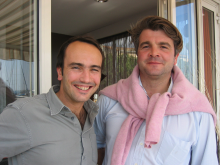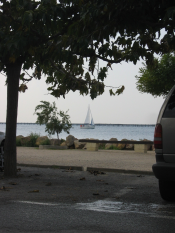BOUZIGUES, France — Gregory Hecht and Francois Bannier operate out of a modest office in this seaside village in the south of France. They are wine negociants after the Burgundy model, though demand for their wines from the Languedoc region is a far cry from what both experienced while working in the Cote d’Or.
You might assume their stock in trade would be the ubiquitous Vin de Pays wines of the region, which have made the Languedoc the largest wine-production zone in France, measured by volume. You would be wrong. I was, and freely admit the Hecht & Bannier wines, under the H&B banner, are a stunning revelation.
 “We chose to start our company in this region because we found we could purchase the most amazing grapes from incredible terroirs at remarkably low prices,” said Hecht.
“We chose to start our company in this region because we found we could purchase the most amazing grapes from incredible terroirs at remarkably low prices,” said Hecht.
Indeed, H&B sources its fruit from the Appellations d’Origine Controlee (AOC’s) vineyards of the Languedoc-Roussillon area of southwestern France. This is one of the oldest and most historic winegrowing regions in France and is treasured for its “old-vine” Carignan, Grenache, Mourvedre and Syrah.
Most of the AOC vineyards are owned and farmed by families that have been growing grapes for generations, and either making wine at small domaines or selling the grapes to the numerous cooperatives that became the dominant players in the Languedoc wine business during World War II.
Hecht and Bannier have a small cellar where they vinify and age their wines in much the same way a traditional negociant works in Burgundy. The wines they make carry the name of the appellation and often the dominant grape varieties used in the blend.
“We don’t work on long-term contracts because we like to take a look at what’s available and purchase the best lots each vintage,” said Hecht.
I tasted two vintages (2004 and ’05) of H&B’s Minervois, a 2005 Saint Chinian, a 2005 Faugeres (“This is a great terroir,” said Hecht) that was stunning, a 2005 Cote du Roussillon Villages and a rose.
What impressed me was the exceptional freshness of the wines. All displayed intensity of flavor without being heavy, and there was a thread of minerality that was common throughout.
 Yet each wine was expressive of its specific terroir and the uniqueness of each blend — the Minervois (Syrah, Carignan and Grenache) showing floral notes and minerals on the nose, with a spicy scent and hints of white pepper; the Saint-Chinian (Syrah, Grenache and Mourvedre) layers of red berries and spice; and the Faugeres a strong whiff of raspberry and darker fruits, while also more powerfully structured.
Yet each wine was expressive of its specific terroir and the uniqueness of each blend — the Minervois (Syrah, Carignan and Grenache) showing floral notes and minerals on the nose, with a spicy scent and hints of white pepper; the Saint-Chinian (Syrah, Grenache and Mourvedre) layers of red berries and spice; and the Faugeres a strong whiff of raspberry and darker fruits, while also more powerfully structured.
What is positively amazing is the price. H&B wines are imported by K&L Wines (of San Francisco and Los Angeles) and others and range from $16 at the lower end to around $28 for something like the Faugeres.
If these same wines were thought to be from the Cotes du Rhone to the east, you would have to automatically double or triple the prices to arrive at the same level of quality.
Hecht and Bannier aren’t complaining, however, for they aren’t paying Cotes du Rhone prices for their grapes, and their vineyard sources are arguably as good or better as anything they could have found in the Rhone.
Clever fellows, this Hecht and Bannier. Even with the awful exchange rate between the dollar and the euro, the H&B wines are seriously undervalued and well worth the effort to find.
PHOTOS: Gregory Hecht (left) and Francois Bannier, top; the scene just steps from the H&B office in the south of France, bottom.
8
